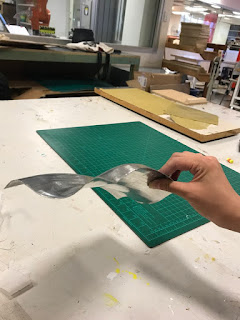Through this reflection, I wanted to critically review the torus I had made for Assignment 1, comparing a fellow class mates results, and then see how this skill could be applied within my discipline of architecture.
PART 1: CRITICAL REVIEW TORUS
Making this torus
was easier than I thought and did not take a long time to create. About 3-4
hours? It was because I opted for a much subtler curve and wanted to focus on
the finish surface of the skin. Comparing my results with a friend’s results,
you can clearly see that he focused on getting a deep grade of curvature for
his torus.
Li Chen's Torus:
My Torus:
There were two
differences. The depths of the cross sectional curves, and secondly the overall
bend through the lengths of the torus. Li had stretched his metal deeper within the central length of the dip and had also created a greater rotating curve on the edges so that they were almost a circular shape.
Li focused on using
the planishing hammer and curved T-dolly to create the curves while I used
different degree of wheels with the English wheel to create my
shape.
I
guess during the process of making this torus, I was hesitant in ruining the
surface of the metal to work the greater depth of curves into it. And a mistake
I had done was not creating enough bend to the metal initially to create the
transverse curve of the torus. Once I had started hammering with the timber mould
to get the central dip, it had already been to late.
If I were to have another go with this one, I would firstly create
a deeper bend to the length of the metal, and then start the hammering process.
Also I would spend more time working the depth of the curves to create a
stronger wave like form. Not only this, but explore other ways the curves could
be incorporated to create a eccentric shape and experiment with other metals.
*
*
*
PART 2: APPLICATION WITHIN MY DISCIPLINE
This course has
allowed me to open my horizons about metal and inspired me to think of ways
metal can be incorporated more within my discipline of Architecture, as part of
my designs and models. Seeing the form of metal change as I work it made me
realise how endless the possibilities are with shaping metal. Unlike
conventional materials such as timber, concrete, and brick; metal is malleable,
yet strong and allows for endless opportunities to be explored within the architectural
realm.

"Fragment No. 5" by Florian Claar

Maison Folie de Wazemmes, Lars Spuybroek
At first, I thought
this class was not going to be of any particular help to my studies and career
afterwards. It was just hitting metal until it become an object. However, forming
the shapes with my hands has allowed an understanding













Comments
Post a Comment